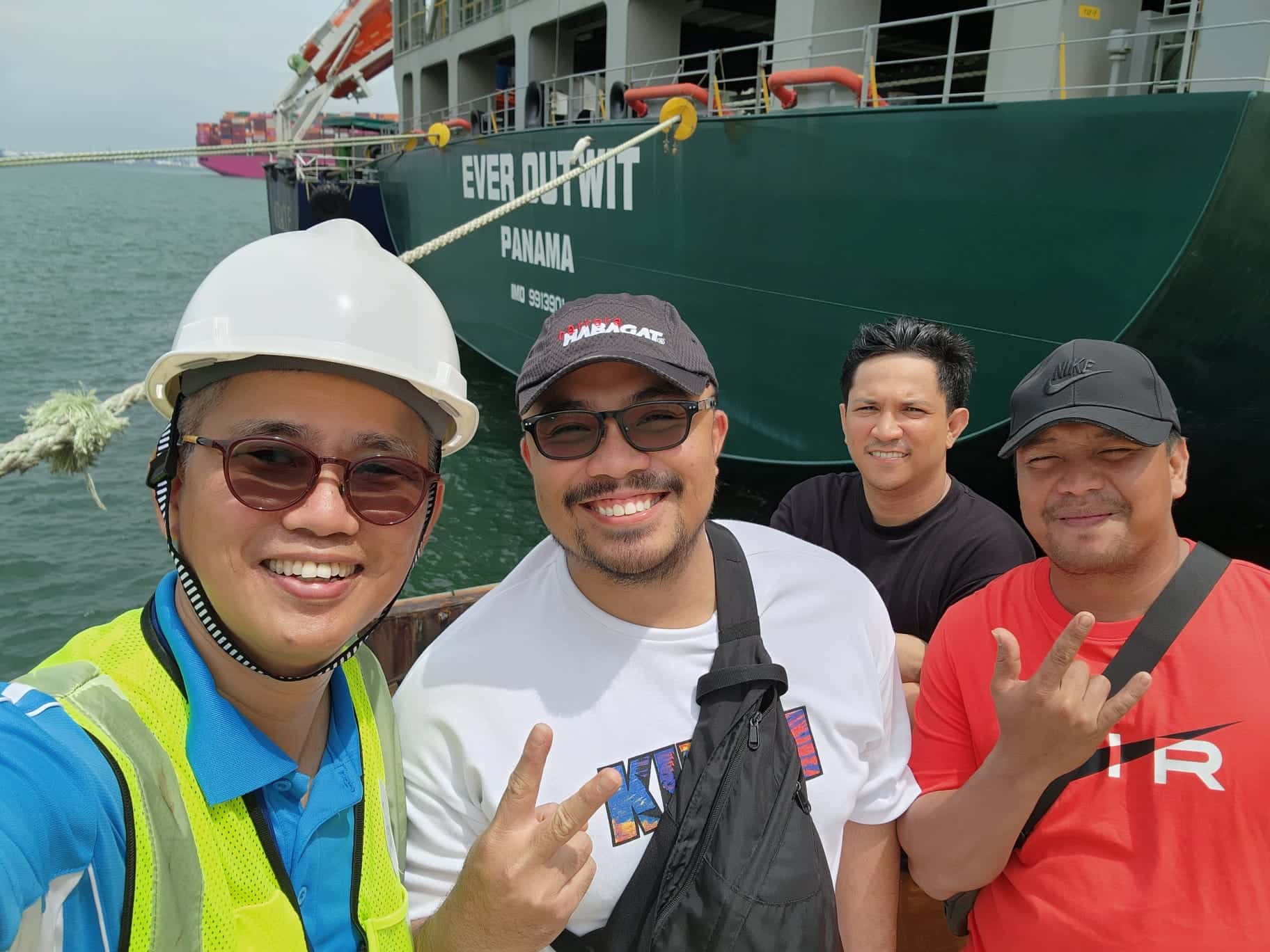“A fresh expression of an Acts 2 church”: How one church’s green renovation ushered in a spirit of caring and sharing
by Gemma Koh // September 1, 2024, 5:51 pm
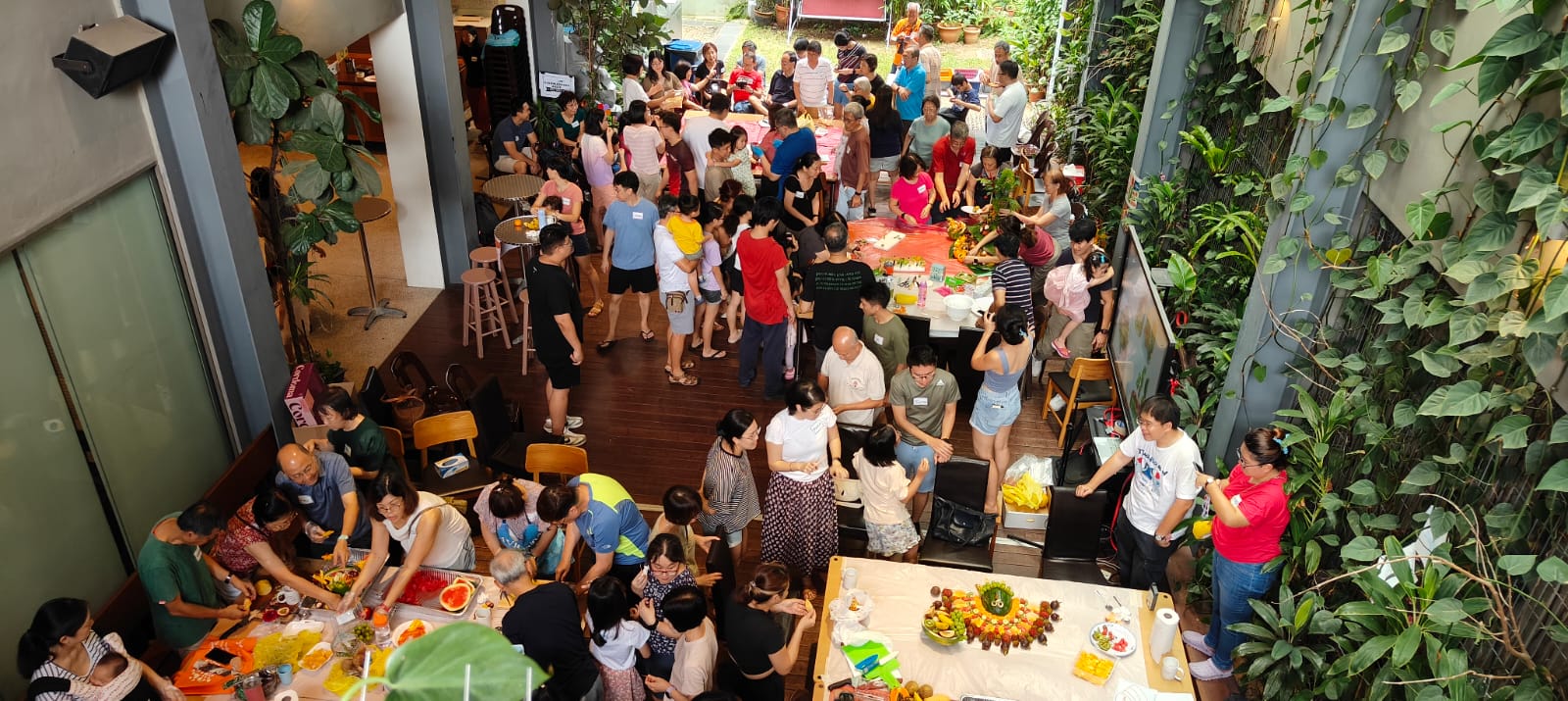
During the church renovation process, God provided the "caretakers of His earth" with practical opportunities for lessons in sharing, friendship and grace – and a surprise doubling of church goers. Photos courtesy of Katong Presbyterian Church unless otherwise stated.
They reoriented the seating in the chapel anti-clockwise (always keeping the cross at the centre of all they do).
They got rid of the hard wooden pews.
They turned their space of worship into a multi-purpose hall that has since hosted the “craziest of things including a warzone with toy blasters during a holiday Bible camp”.
Katong Presbyterian Church (KPC) at Joo Chiat Lane made these radical changes when it renovated its 40-year-old building that leaked when it rained. It had fallen into a state of disrepair.
This reorientation could be seen as a metaphor of the church’s desire for a distinct change, one that God would honour beyond what KPC asked for or imagined.
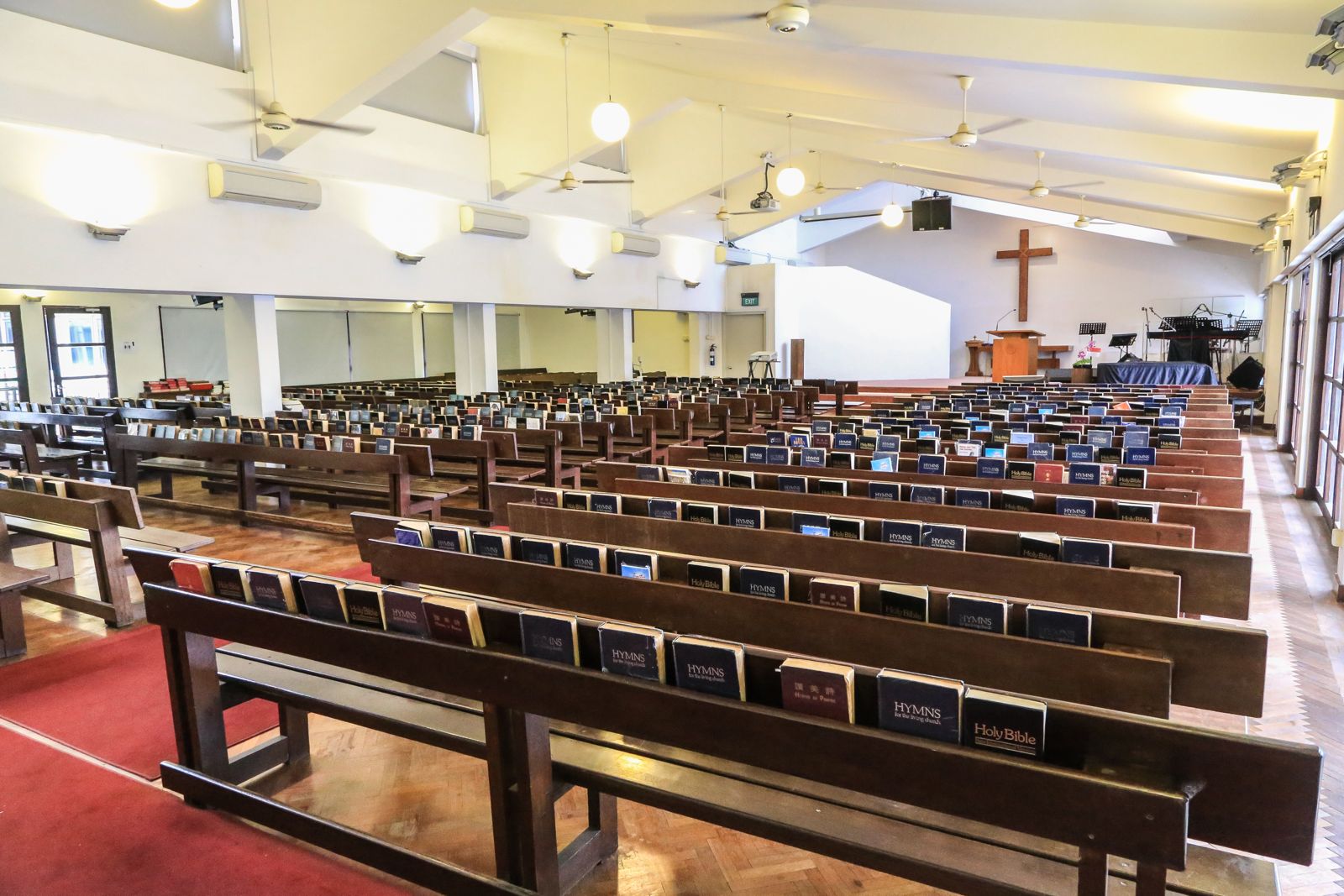
These wooden pews were removed from the old church sanctuary and replaced with stackable armchairs. The seating in the church was re-oriented anti-clockwise to form a U-shape about 10 rows deep, drawing the congregation close to the centre.
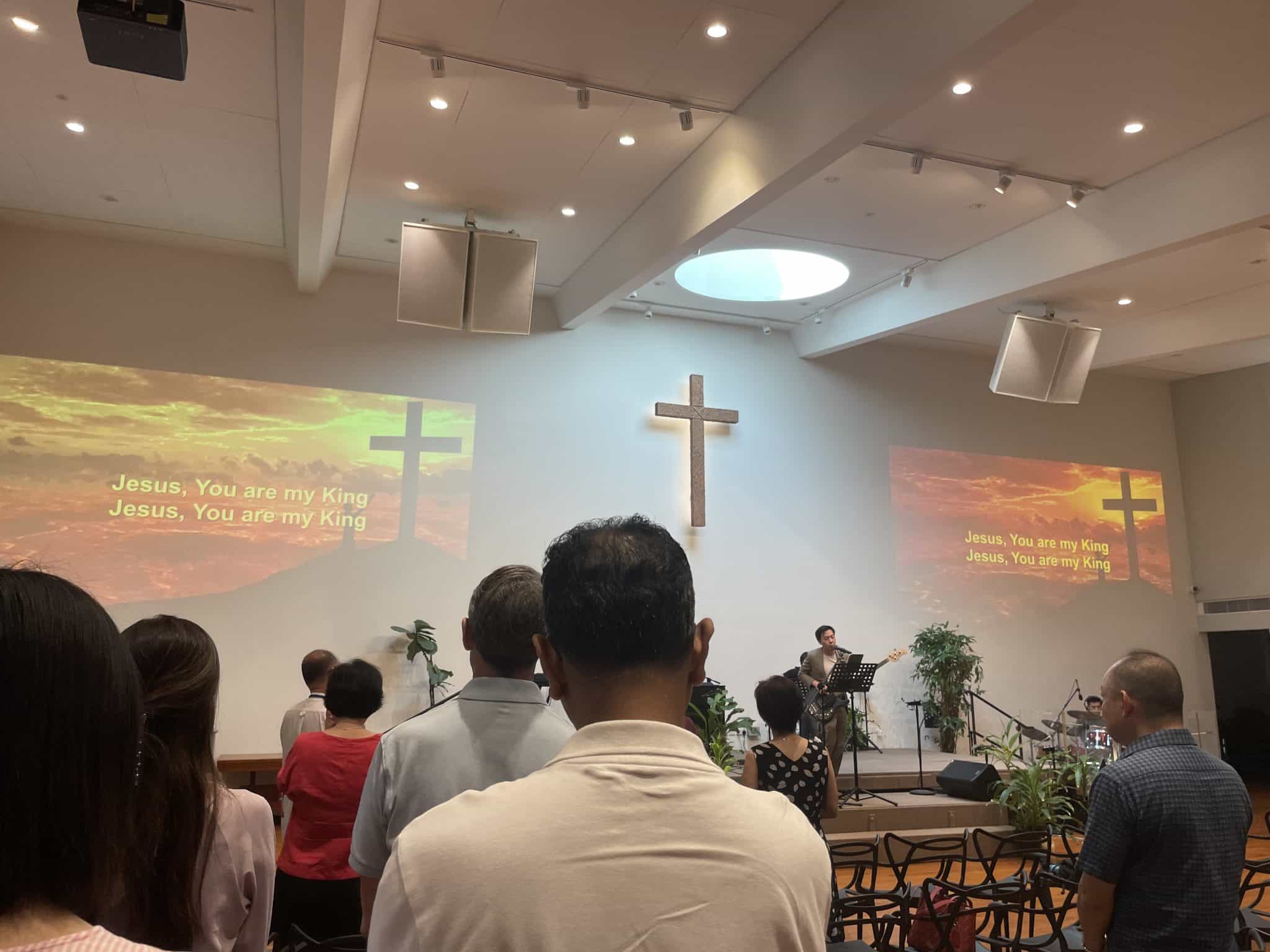
KPC’s new chapel: “When I look at the cross that points to the heavens (through the hole in the ceiling, pictured), our praise to God as Creator feels more meaningful and powerful,” said Senior Pastor Lam Kuo Yung. Photo by Gemma Koh.
“We wanted to be a fresh expression of an Acts 2 church in today’s world,” church elder Dr Goh Wei Leong told Salt&Light.
“We wanted to embody the spirit of the first century church, which prioritised studying good teaching, fellowship, sharing meals and prayer.”
“We wanted to embody the spirit of the first century church, as described in Acts 2:42, which prioritised studying good teaching, fellowship, sharing meals and prayer,” he added.
KPC’s Senior Pastor Lam Kuo Yung told Salt&Light: “As our community prayed and planned, we filtered our decisions – such as renovating rather than tearing down and rebuilding – through the five values we want to live out as a church instead of having a mindset of wanting more parking spaces and more rooms for individual ministries.”
One of these values, to be “caretakers of the earth”, was especially relevant.
“Around that time, the world was becoming aware of the ecological crisis and almost every other day, there would be something in the newspapers about some form of disaster,” said Ps Kuo Yung.
The guiding principles had emerged after a period of reflection during a leadership vacuum in 2010. KPC also aspires to be lovers of all people; disciples making disciples; bridge-builders across generations and upholders of justice and mercy.
The building project involved church members every step of the way, from its ideation in 2010 right down to furnishing the newly-revamped premises with pre-loved furniture in March 2018, shortly before COVID hit.
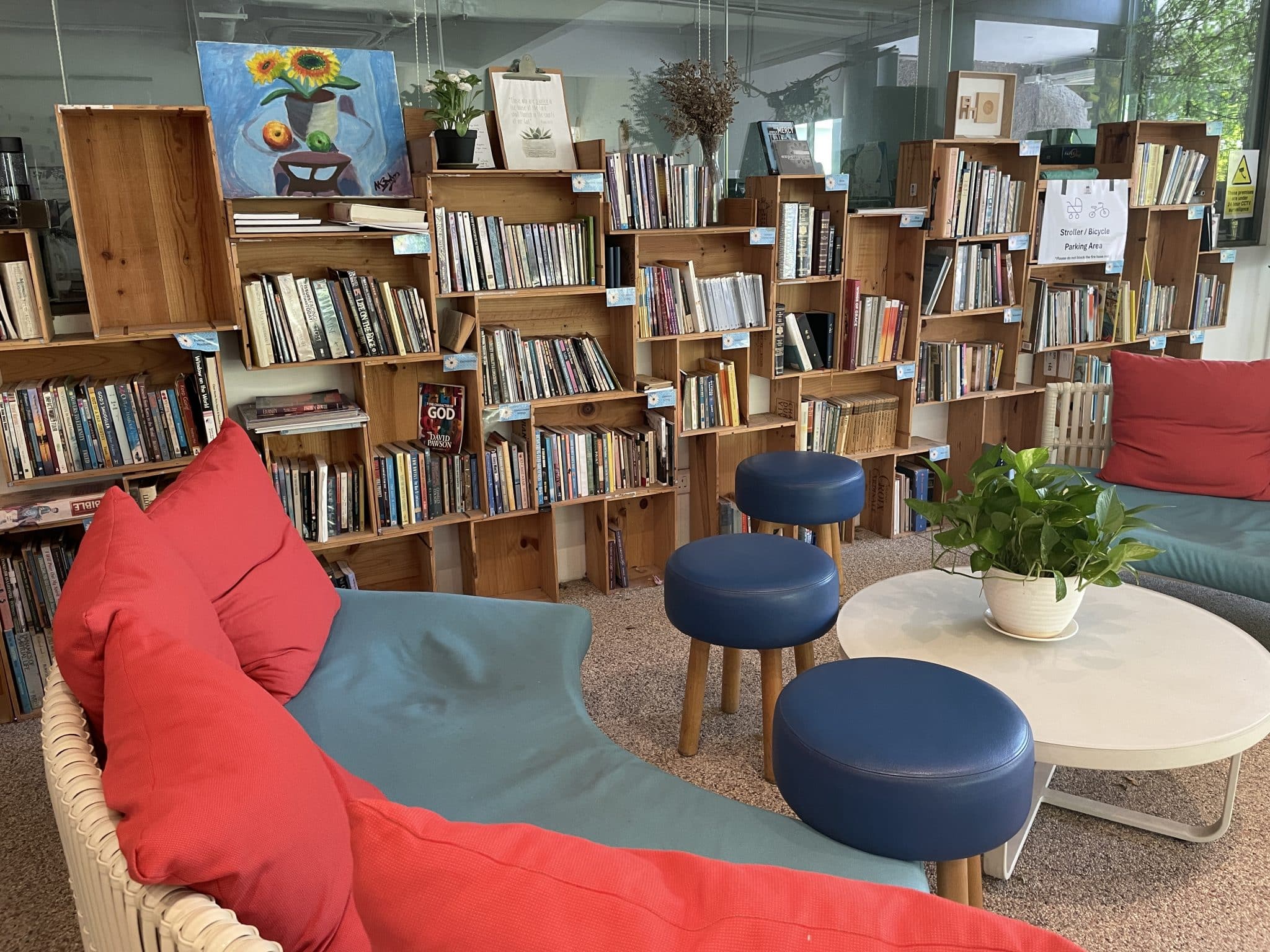
Members expressed their love for God and their community by giving their time to create welcoming, cosy spaces like the library at the church foyer. Photo by Gemma Koh.
“People felt a sense of ownership in the entire project,” Ps Kuo Yung said.
They grew as a church – in all senses of the word – without realising it.
Going through the renovation process, the church experienced God and His provision in unexpected ways, and found opportunities to learn how to practically live out the Christian faith.
Seven-year runway
KPC’s overhaul had a seven-year runway before the actual brick and mortar renovations started in November 2016.
“Before we started, we went through a lot of thinking about what we hoped would happen,” said Ps Kuo Yung.
“We took time with our church members to ask, ‘What are the values that we want to live out in renovating our church?’
“We wanted to learn these values in a deeper way before we attempted the renovation.”
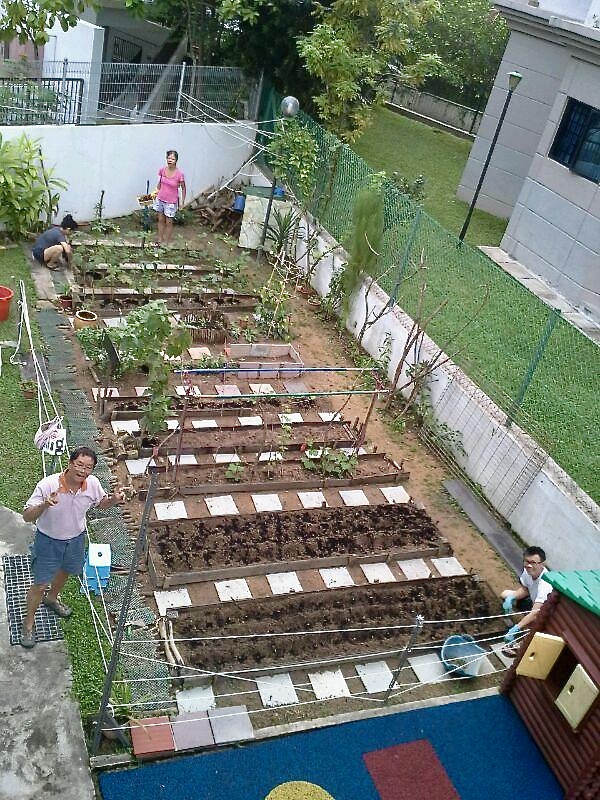
“You can’t protect something you don’t love,” explained Ps Kuo Yung on helping members appreciate God’s creation via the formation of a small farm in its compound where members grew vegetables and herbs – and cared for God’s creations like rabbits and birds.
The pastor added: “At the same time, we wanted our community to be more involved in deciding how the renovation should be done.
“When we set that as a target, we found that we needed to educate the community if we wanted to involve them.”
“You can’t protect something you don’t love”
Beyond a sermon series on creation care and other events, KPC embarked on a series of experiments.
One of the first was bringing nature close to the church to enable members appreciate God’s creation more.
“You can’t protect something you don’t love,” Ps Kuo Yung pointed out.
So a grass patch at the side of the church was transformed into a small farm. Members rolled up their sleeves and got their hands dirty growing vegetables and herbs, and caring for God’s creations like rabbits, birds and quails.
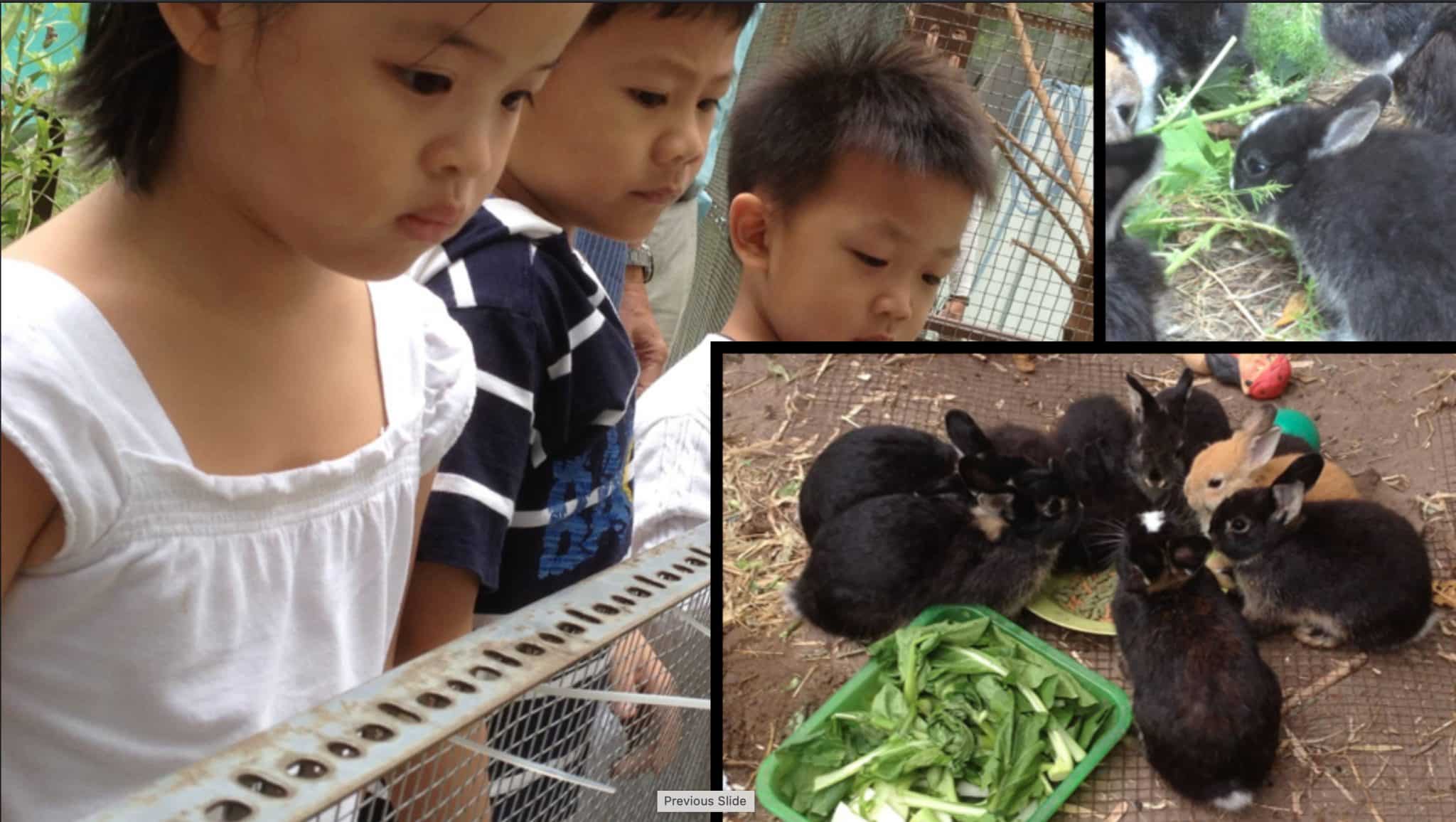
The farm also comprised an aviary for birds and a hutch for rabbits – a hit with the children.
Through that experience, members encountered who God is, as Ps Kuo Yung had hoped.
“Those who worked in the vegetable garden saw just how much work you have to put into caring for the garden daily, how much patience you need to have, and also how much you have to trust God for the right weather, for the right environment to have a harvest.
“All that helped us to better understand how God nurtures us.”
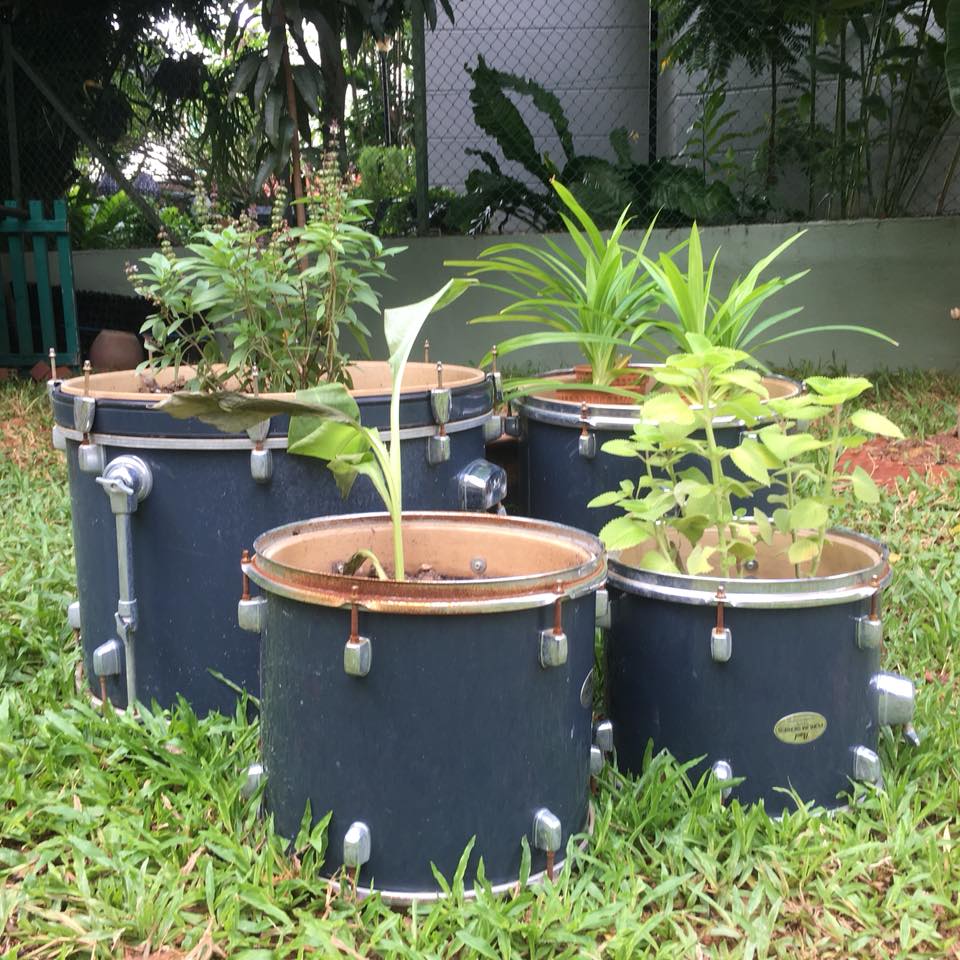
Old drums were repurposed into planters for herbs. A large part of the farm was later turned into a playground for children – an example of how the use of space evolves with the church’s needs.
As members reaped the joy of harvesting fruits and vegetables, they also realised they could share the harvest – and their lives – with others.
The church began hosting weekly Thursday community dinners, inviting everyone in the neighbourhood. (Since COVID, these dinners are held twice a month).

Different groups of people – the homeless, construction workers – are drawn to the Thursday dinners in different seasons, observed Ps Kuo Yung. Currently, the church sees many foreign university students.
Supplemented by potluck dishes contributed by church members, the kitchen would cook up the vegetables, which the group would highlight as “must try”. “This is most organic, grown and harvested in our church,” said Ps Kuo Yung.
During the renovation which took a year and a half, the church chose to stay on in its premises instead of renting a comfortable space for worship.
Again, this brought opportunities for building relationships.

Wei Leong (left) at the appreciation lunch to honour the workers, contractors and their teams who rebuilt the church.
“As Christians, we are agents of social justice. How to show this? One way is to love migrant workers by being their friend. Where got opportunity? When they are renovating your house and you are there,” Ps Kuo Yung explained.
Proxy spaces
Staying put during the renovations also gave the church practical opportunities for discipleship and grace.
At one point, for six months to a year, they were down to “half the space and zero carpark”.
Choosing “the path less travelled” meant the possibility of conflict, the pastor acceded.
With limited space, came clashes in booking of rooms for ministry needs.
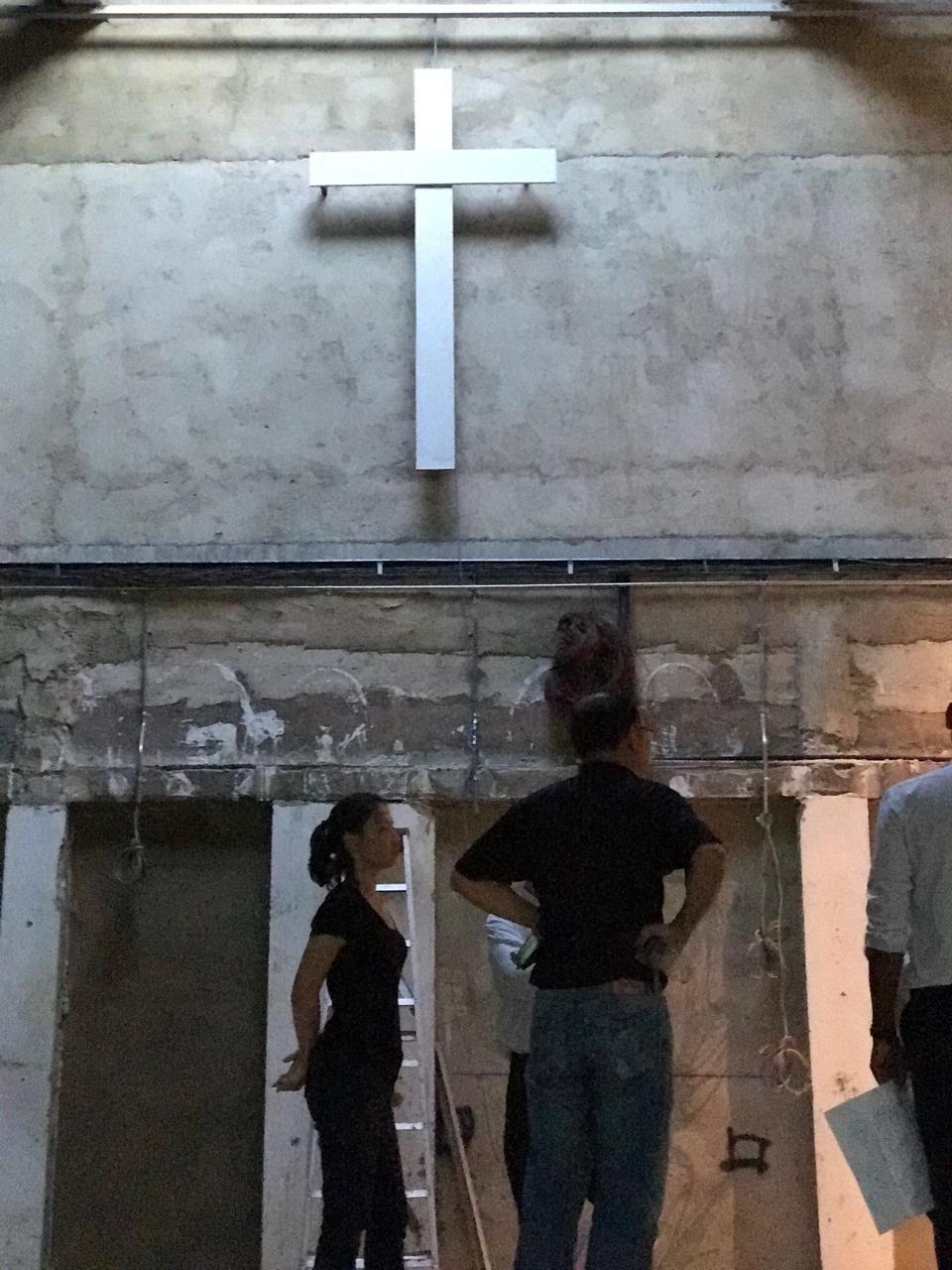
Placing the cross in the chapel during renovations.
“People would get frustrated,” Ps Kuo Yung admitted. “But we made a conscious decision not to get upset. The whole purpose of this exercise was to learn to share.”
Discomfort opened the door for discipleship, grace and friendship.
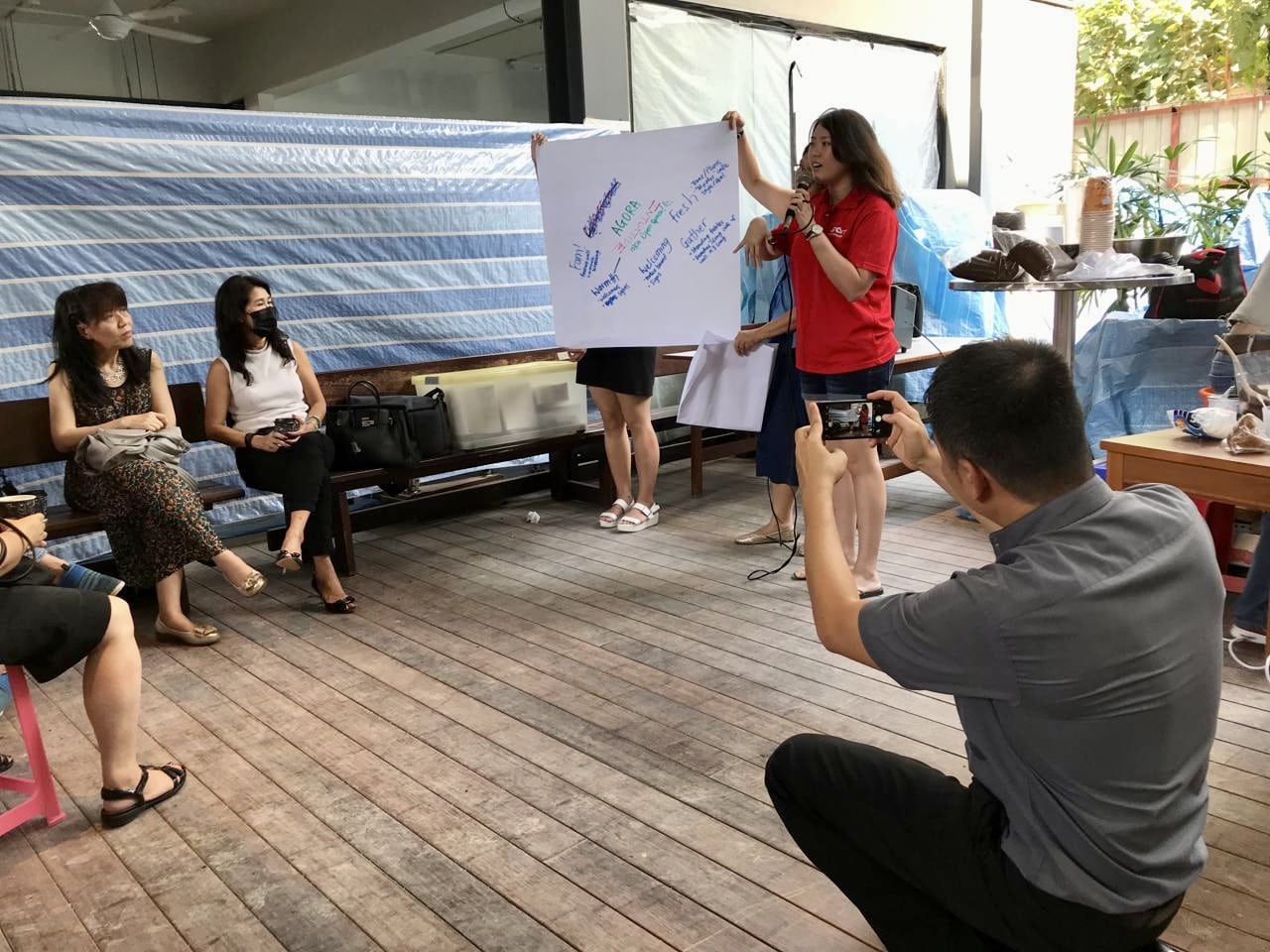
During the renovation, KPC held “festivals” involving the church community. Here, they shared their ideas and dreams for the Agora (meeting space).
During the renovations, even the nearby coffee shop became “a proxy space”.
“Members experienced firsthand that when resources are low, there will be enough,” he said.
“As we bore with the inconveniences and witnessed the gradual transformation of the building together, the entire church felt integrally involved in the renovation process,” wrote Ps Kuo Yung and Wei Leong in a chapter “Building a Building and a People” of the anthology God’s Gardeners.
Similarly, having minimum carpark lots (required of a building its size) was a great opportunity to learn to share.
It wasn’t just the monetary cost – $1 million – or an issue of being environmentally-friendly that the church did not opt to have a basement carpark: They wanted more space for people than cars.
So members carpool or use the church shuttle service that runs from Eunos MRT. The benefit goes beyond minimising their carbon footprint.
“People have learnt to become more generous, reserving the limited lots for people with real needs,” noticed Wei Leong.
Ps Kuo Yung said: “Jesus’ instruction was to teach people to obey everything He has commanded (Matthew 28:20). This is different from teaching them everything he commanded, which is theory.
“The way to teach them to obey is through practice, so having limited parking space is one opportunity to learn to share.”
The Christmas fiasco
This shift in culture also caused members – as well as the church leadership – to re-examine the way they lived and acted.
The most memorable incident was one Wei Leong dubbed “the Christmas fiasco”.
“We realised that effecting change in the community cannot occur through an overbearing or holier-than-thou posture.”
In an early effort to move away from disposable plates and utensils, members were told in advance to bring their own reusable ones for Christmas lunch one year.
“Some forgot or did not heed the message,” said Ps Kuo Yung.
“When we pointed out that we didn’t have disposables but had reusable utensils and a collapsible lunch box that they could buy for $10 as part of fundraising for the building project, some people refused to buy them and walked out after the Christmas service.”
In “Building a Building and a People”, Ps Kuo Yung and Wei Leong wrote: “It was a critical lesson for us. We realised that effecting change in the community cannot occur through an overbearing or holier-than-thou posture. Rather, we had to hold our idealism in tension with a realistic and gracious acceptance that people take time to change.”
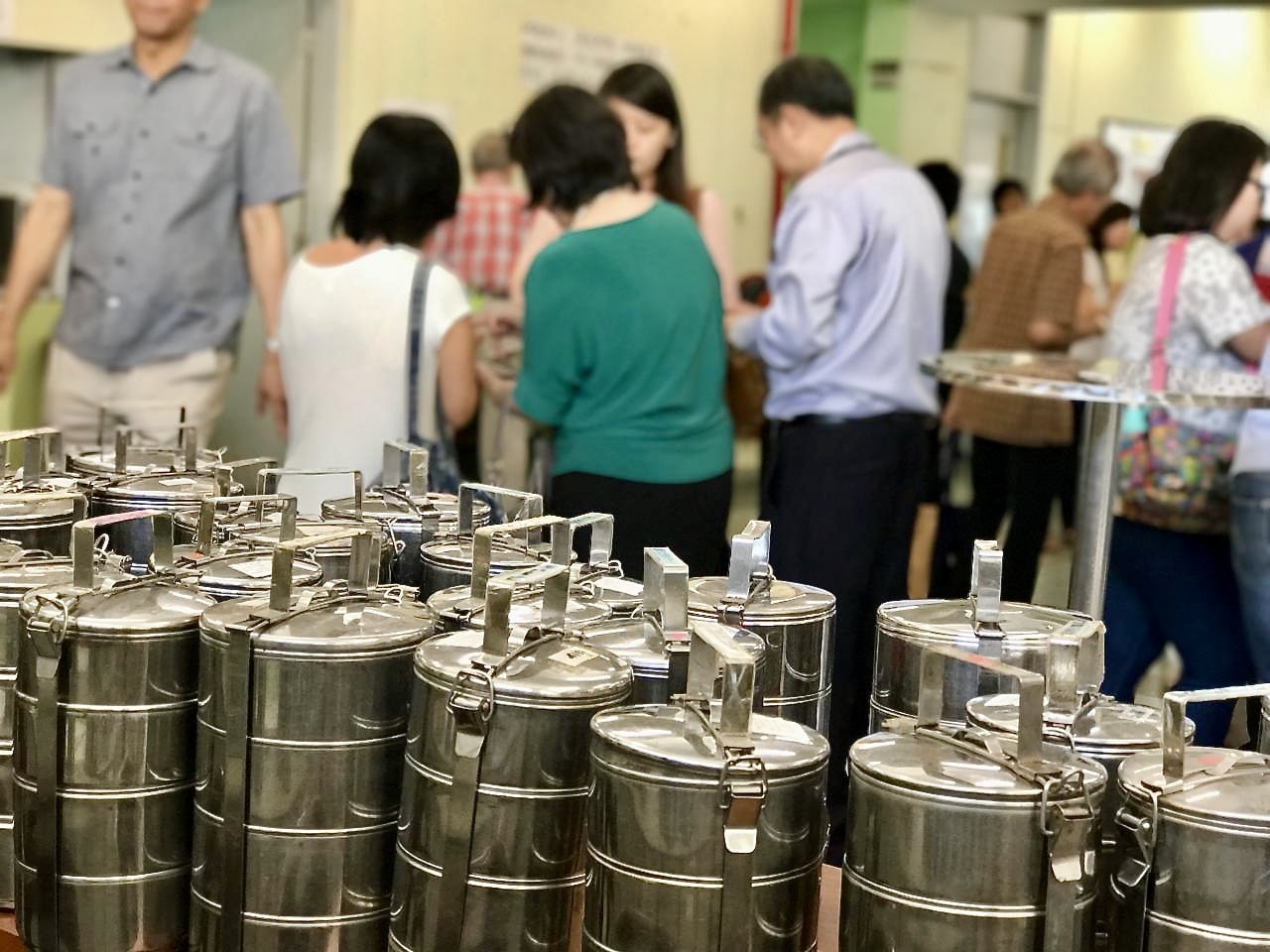
Reusable food containers – tingkats – have been among items sold to raise funds for the community building project.
Now the church has its own supply of reusable cutlery and plates, inherited from a restaurant that was closing down.
It is one of many instances they’ve seen of God’s provision and perfect timing. Disposables are no longer used during community meals, except for the odd gathering when the crowd is too large.
“Why is your church like that?”
Visitors to the church, who are used to ubiquitous disposables in Singapore, are surprised by the reusable plates, cutlery and cups.
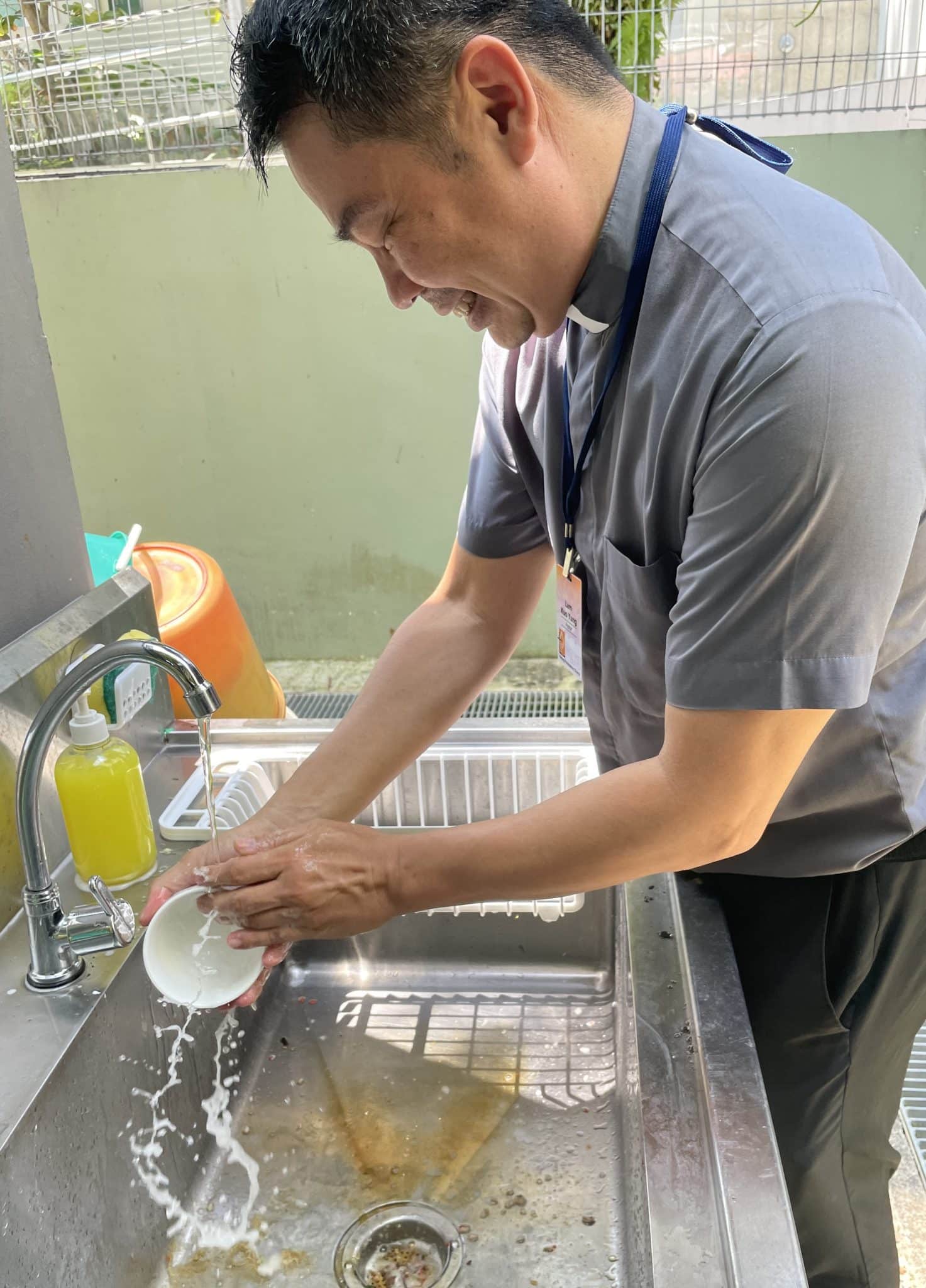
Even visitors and the church’s own Senior Pastor Kuo Yung wash up after themselves. The washing point has become a starting point of many conversations. Photo by Gemma Koh.
“It becomes a conversation starter. They will ask, ‘Eh, very interesting, Why is your church like that?'” Ps Kuo Yung said.
Similarly, the sheer amount of greenery – in the chapel and at the multi-purpose meeting space, the Agora – invites conversation about faith.
Ps Kuo Yung said: “We ask them, ‘Do you feel more relaxed, calmer? Do you feel like staying longer in church?’ The answer is inevitably ‘Yes’.” (This writer gave a resounding yes.)
The Agora is a welcoming high-ceilinged open area that draws the community together for meals and other activities.
The pastor said: “Our architect, Derek Chan, held us accountable to our values, and mindfully put them into the design of the church, including minimising the areas that needed to be air-conditioned.”
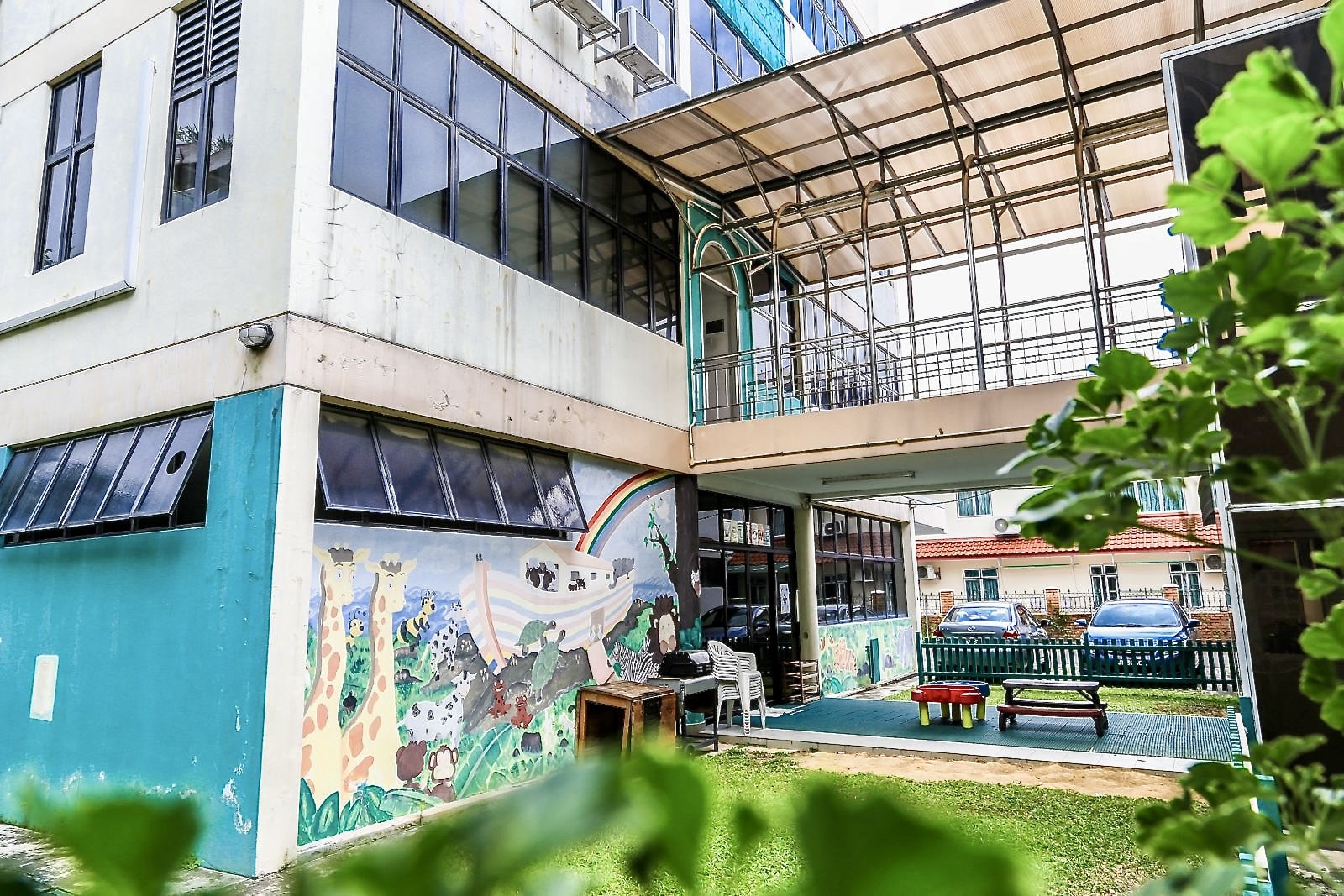
The previous space where the Agora now sits. In ancient Greek cities, the agora was an open meeting space where its citizens gathered for various activities.

Churchgoers enjoy coffee and breakfast on Sundays and other activities at the multi-purpose Agora. Its high ceiling and a giant fan allow for more ventilation and air circulation.
Visitors often comment that the church feels like home. They notice that no two pieces of furniture are alike in places like the meeting room and babies room.
“We tell them we inherited the furniture from an ice-cream cafe that was closing down or bought pieces from Carousell because we don’t want to get brand new stuff,” says the pastor.
The next question is inevitably, “Why? Is it to save money?”
“Then we are able to explain it is more because we want to take good care of God’s environment.” (See box at the end of story.)
Creativity and God’s provision
As church members became highly attuned to opportunities to saving money, sourcing for furniture that was being given away, creativity also flourished as they found various ways to address various problems and needs.
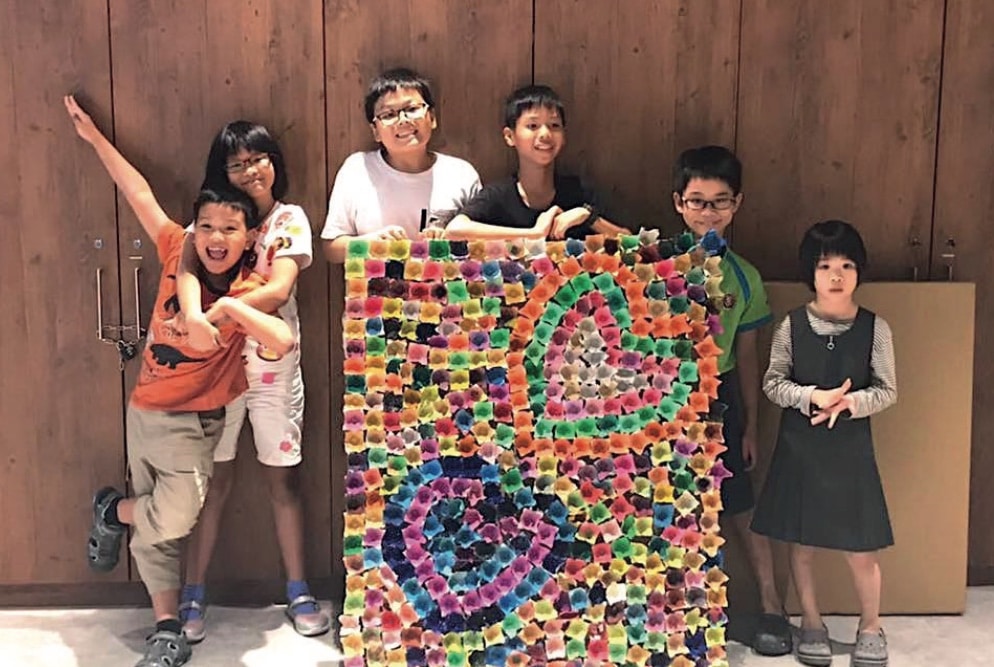
Art pieces around KPC were not purchased, but were created lovingly by different groups of members from juniors to seniors.
Including transport costs, Wei Leong estimates they spent only 20 to 30% of what they would have on brand new items.
“Creativity is a gift from the Lord. The Holy Spirit inspired us,” said Wei Leong.
“The renovations allowed people to express their love for God and the community on many levels,” said Ps Kuo Yung, pointing out how members dedicated time to curating the furnishings.
They were also elective about pre-loved items they accepted: “We are not a junkyard for old equipment.”
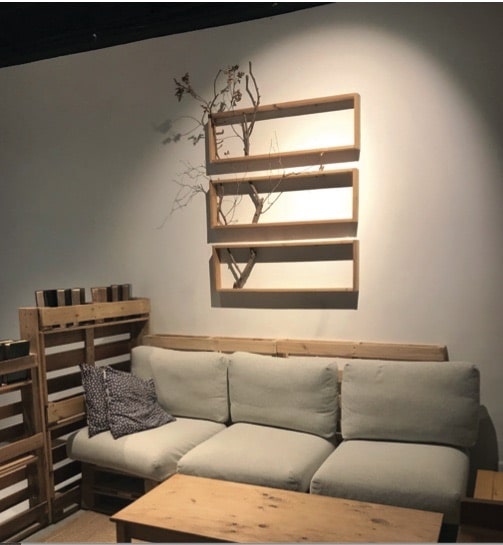
“When people sit on a sofa built by their own brother at church, they are more appreciative of it than a store-bought one,” said Ps Kuo Yung. This set was made from wooden pallets.
They saw how God provided – many times – at just the right moment.
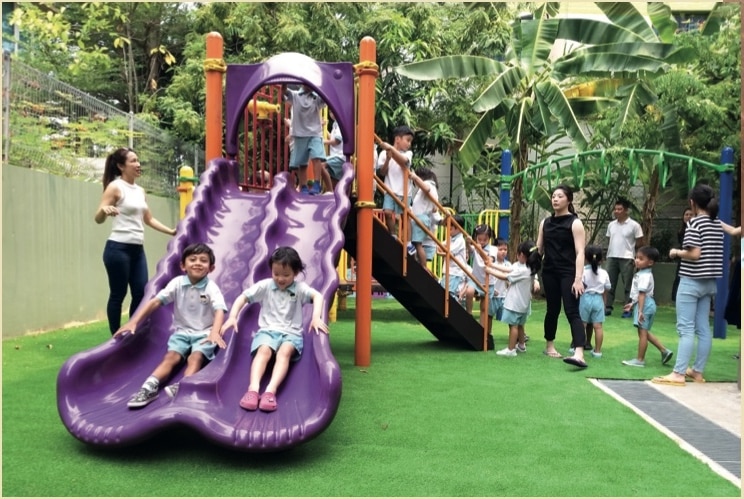
A church member found this good and sturdy playground set that would have otherwise been discarded by an institution simply because they had the budget to replace it. The builder added in other parts to reflect the design envisioned by children and their parents.

Giant ideation board with input from children, parents and church members of the kind of playground they envisioned.
One member discovered that one organisation was renovating and was giving away office equipment, including pedestals for desks.
“The Lord’s timing is always perfect. The new equipment even matched our colour scheme. It’s amazing how God provides,” Wei Leong marvelled.
From pews to “pew! pew! pew!”
The church is open to sharing their spaces “to show that Christian spaces can be creative, generous and filled with joy”, said Wei Leong.
One goal of the renovations was to make its spaces more accessible to the community, “as part of our creative stewardship of what God has entrusted us with”.
This includes turning the chapel into a multi-purpose hall. Were there objections?

The church commissioned non-profit organisation Ground-Up Initiative to remove and repurpose the pews into furniture that are now used around the church. Some upcycled items were used to raise funds from those “who wanted a piece of church history”.
Ps Kuo Yung said: “It became an opportunity to talk about what holiness is.
“Holiness doesn’t mean not drinking coffee in chapel. Or trying to hoodwink the Lord by saying, ‘I am being holy by not wearing slippers to church.’ Playing games with kids and sharing a meal together and doing life together is also a holy act.”
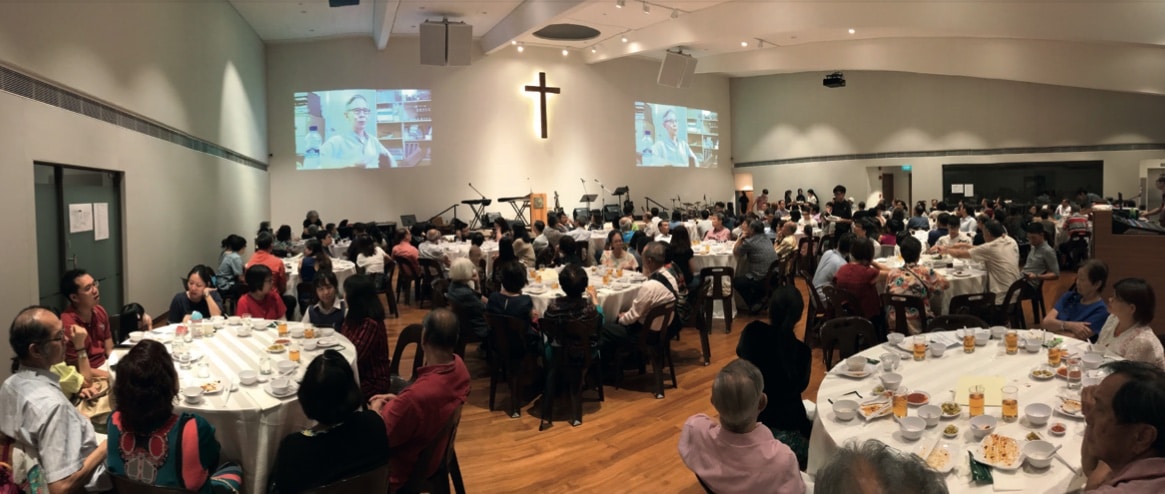
A fundraising dinner with Chinese banquet tables was held in the chapel.
Wei Leong added: “It allowed members to think more of what the Christian life means in the light of what they do. It goes beyond following a list of dos and don’ts.”
The church commissioned non-profit organisation Ground-Up Initiative (GUI) who dismantled the pews and took them to their campus at Sembawang. (GUI’s mission is to reconnect urbanites with nature and the community, to inspire them to make sustainable lifestyle changes.)
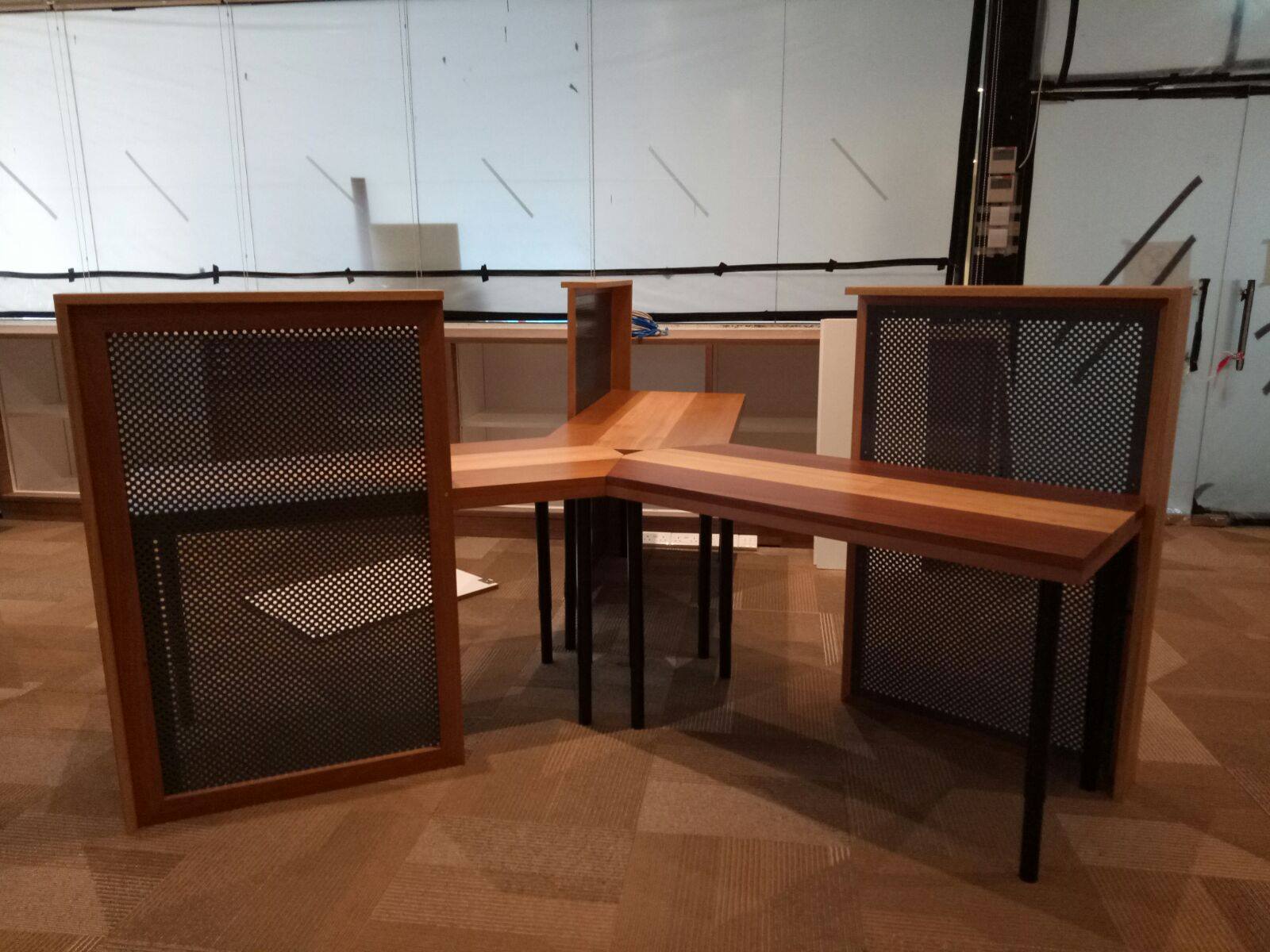
Upcycled from pew wood, these desks are arranged in clusters of three “like a Mercedes logo” to provide users with some privacy in the open-concept office.
“They were very happy to collaborate with us, and helped us refashion the pews into desks and other pieces of furniture that are used around the church.
“It was so much more meaningful than getting a big company to design brand new furniture for us,” said Wei Leong.
“GUI were also intrigued to be working with a church, and intrigued by why we want to take care of God’s world.”
Two churches become one
But the biggest surprise and test “of epic proportions” from God came six months before the end of the renovations.
Hope Presbyterian Church (HPC) had lost its premises, and approached KPC looking to rent a place for their worship services.
“Imagine: You haven’t moved into your newly renovated home, and someone with a similar-size family asks to share your premises,” described Ps Kuo Yung.
“It was a big request. It was a struggle for the church leadership.”
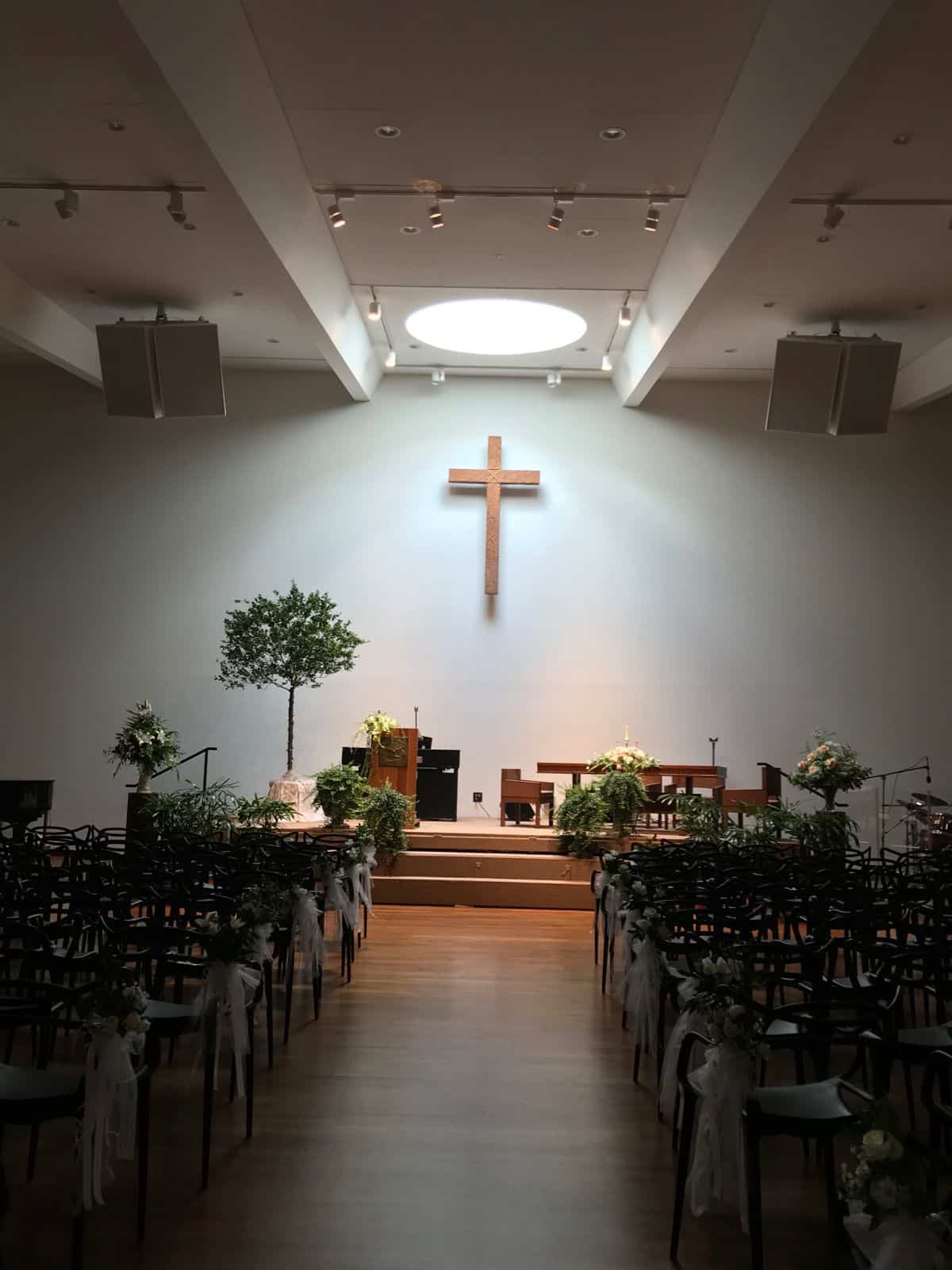
The chapel decorated for a wedding. Sunlight streaming down creates a spotlight on the cross that moves across the stage during service. “It is a wonderful reminder that God is with us,” said Wei Leong.
“Then we reminded ourselves, ‘Didn’t we tell God that one of our objectives of the renovation was to prepare to share the premises with more people?’
They put it to a vote, and 94% of the congregation said yes to another church using their brand new building.
Wei Leong said in a 2019 interview with Salt&Light: “Can you beat that? I was so pleased because I think the values had been absorbed.”
Said Ps Kuo Yung: “We all realised that we couldn’t turn away someone with a need when we were clear what God wanted us to do.”
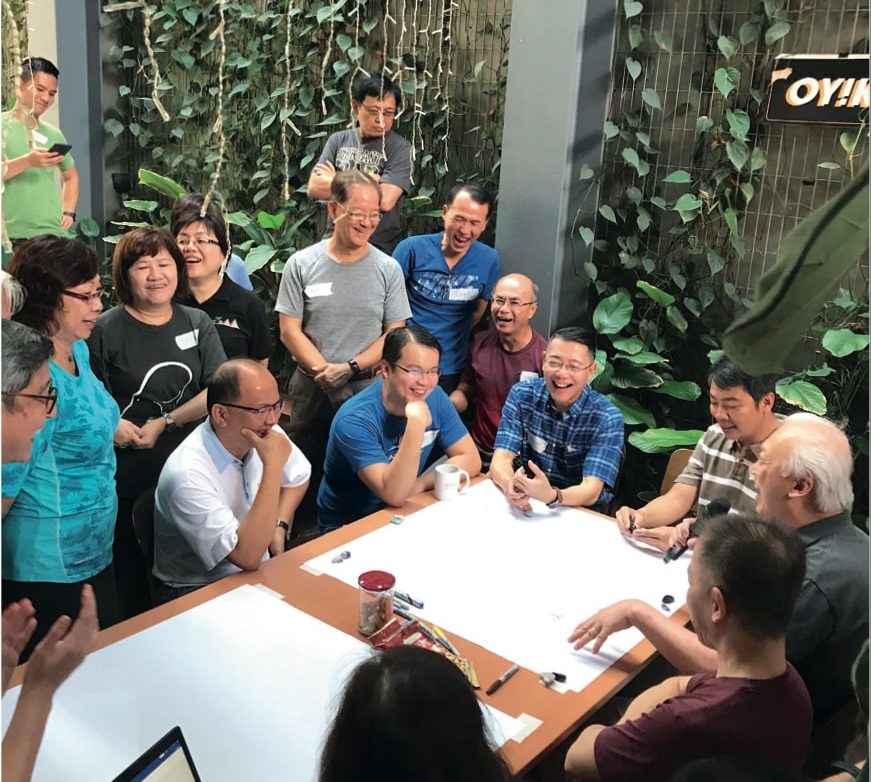
Members of KPC and HPC together: “We felt led to respond and engage with each other through the lens of a covenantal relationship,” said Ps Kuo Yung.
After a few years of worshiping together, HPC asked to explore becoming one family with KPC.
On January 1, 2024, “the marriage happened”, said Ps Kuo Yung.
And just like that, their congregation size of 400 went up to more than 600. On a Sunday, congregants are spread over two English services, a youth service and a Mandarin service. The chapel has a seating capacity of 240.
“Our biggest project now is integrating everybody,” said Ps Kuo Yung.
“The whole purpose of coming together is to be better stewards of resources that both churches have. We believe we can do the Great Commission better together.
“In the months we’ve been together, the signs indicate that this is true.”
The journey continues
Ho Wei Hao, co-author of The Generations Project (a research study on the intergenerational Church in Singapore) has described KPC’s culture as one of “innovation”.
Said Ps Kuo Yung: “In today’s rapidly changing world, it is crucial for the church to innovate to stay relevant. If members are afraid of making mistakes or trying new approaches, it will be difficult for the church to progress.”
Case in point: During a sermon series on Acts 2 on how God’s people live together, share and care for one another, an app for members to share household items like drills was created, but did not gain traction.
The journey to becoming more generous and connected with God is “a work in progress, one long learning journey that is still ongoing today,” said Wei Leong.
If your church is thinking of renovating …
Katong Presbyterian Church (KPC) has written a reflection of their renovation journey in the form of toolkit, with useful considerations for churches preparing to update their premises.
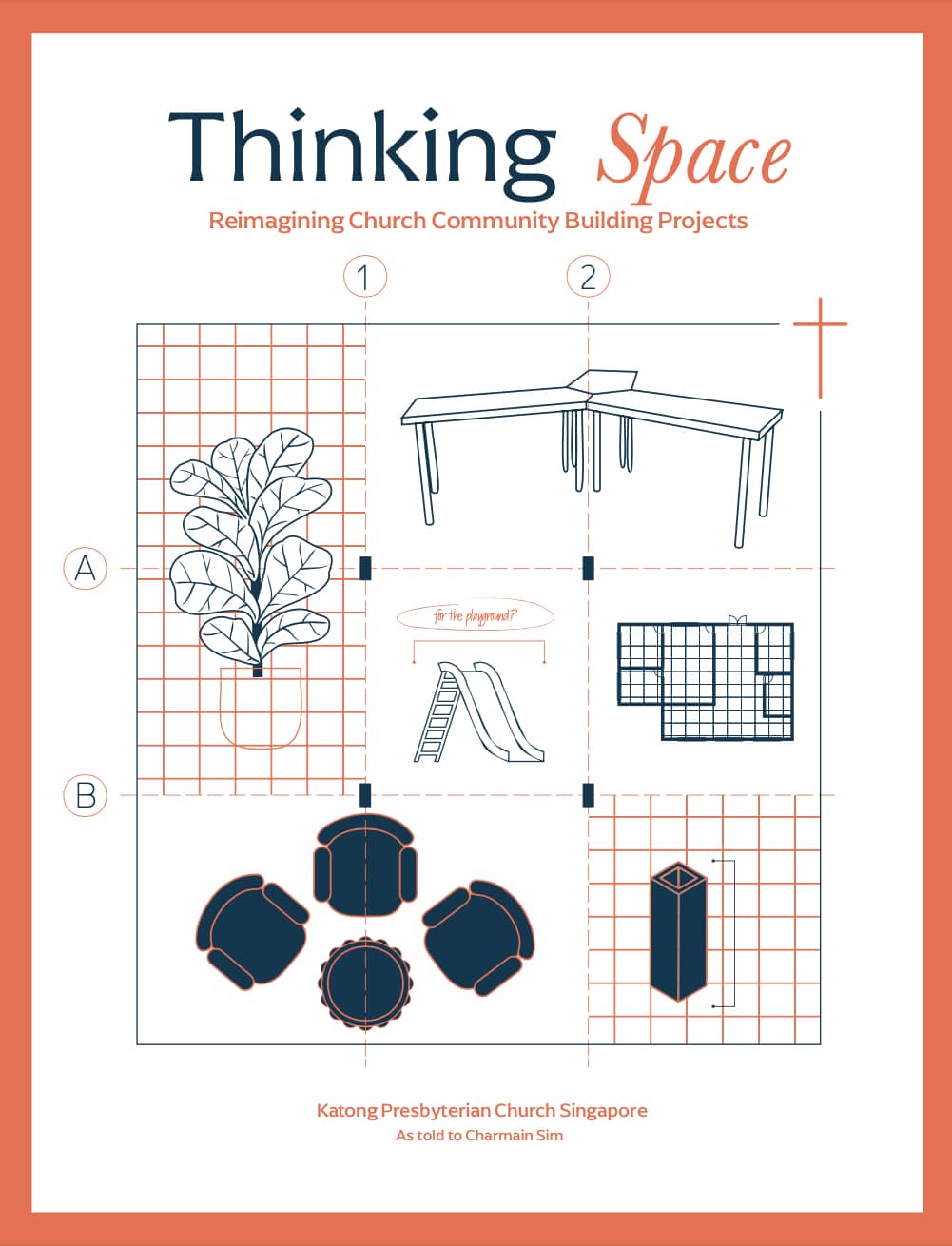
Thinking Space: Reimagining Church Community Building Projects will be launched during worship services at KPC on Sunday September 8, 2024.
The books are $20 per copy ($15 each, if more than 10 copies are ordered). Order books from the church office, for self-collection. Email [email protected].
Taking care of God's world, loving our neighbour
Rather that dive into the theology of creation care, Ps Kuo Yung prefers to share about two aspects of caring for God’s creation:
- All through scripture – and not just in Genesis 1 and 2 – we are called to be good stewards of God’s creation and all kinds of resources that God has given us.
- Loving our neighbours. “There is also very clear teaching in the Scripture to love our neighbours. Taking care of your neighbour’s front yard and backyard is one of the most loving things you can do in today’s context.
“During the recent Community of Practice Session organised by Creation Care Sg (since renamed as Our Father’s World), we discussed how churches can reduce carbon emissions to protect the environment. When we work together as a church, we can demonstrate the gospel love we are meant to show to those around us. The Bible reminds us in James that faith must be accompanied by action. It’s not enough to simply say we love our neighbours; we must actively show that love, including caring for their environment.”
Wei Leong noted that when we look at the bigger picture, global warming and droughts are affecting people’s livelihoods, forcing them to seek jobs elsewhere. This situation can also lead to human trafficking.
He acknowledged: “I may be oversimplifying a complex issue, but it raises the question: “What is the church doing about it?”
Ps Kuo Yung said: “Initially, creation care was viewed as a standalone issue, but it has evolved into a justice issue when people realised that those who suffer the most from environmental neglect are often the poor.”
He explained: “The wealthy can afford to be more careless about environmental issues. For instance, they can escape the consequences if temperatures rise by simply retreating into air-conditioned buildings. But in poorer countries, people can suffer from heat exhaustion and even die.”
Creation care became an integral part of discussions at the Justice Conference Asia 2019, as reported in Salt&Light.
RELATED STORIES:
“Singaporeans need to learn to live with mess!”: 2017 Singaporean of the Year Dr Goh Wei Leong
Creation matters “because it’s the handiwork of God”: Conservationist Peter Harris
We are an independent, non-profit organisation that relies on the generosity of our readers, such as yourself, to continue serving the kingdom. Every dollar donated goes directly back into our editorial coverage.
Would you consider partnering with us in our kingdom work by supporting us financially, either as a one-off donation, or a recurring pledge?
Support Salt&Light

